1a. Fruitbody small; stipe apex usually ≤ 4 mm across, never drab apically; cap usually ≤ 50 mm broad, orange, tawny, or yellow-brown, but never green or drab
..........................................................2
1b. Fruitbody medium to large; stipe apex usually > 5 mm across, color varied; cap usually ≥ 50 mm broad, varied in color, including green or drab
..........................................................5
2a. (1) Basidiospores ellipsoid, minutely punctate ornamentation and slightly pointed apical callus visible under high power oil immersion; clamp connections present
..........................................................3
2b. Basidiospores limoniform, verrucose to warty ornamentation and protruding apical beak visible without oil immersion lens; clamp connections absent
..........................................................4
3a. (2) Spores small, ~5.8 × 3.2 µm; cheilocystidia thick-walled, tibiiform with narrow necks, abundant but inconspicuous and difficult to see; fruitbody collybioid with stipe pliable, not easily broken; phenology autumnal (October–December)
..........................................................P. radicata
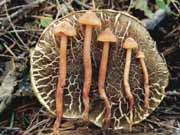
Ron Exeter
3b. Spores large, ~10.3 × 6 µm; cheilocystidia thin-walled, narrowly clavate, extending well beyond hymenium; fruitbody mycenoid with stipe fragile and easily broken; phenology vernal (April–May) or autumnal (October–December)
..........................................................P. phaeogaleroides
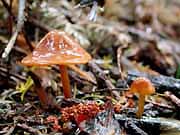
Ron Exeter
4a. (2)Stipe and pseudorhiza fleshy, not shiny or brittle; cheilocystidia thick-walled, tibiiform; pleurocystidia similar, frequent on gill faces; spores tapering to straight beaks, ~9.2 × 6 µm; phenology vernal (February–May)
..........................................................P. pleurocystidiata
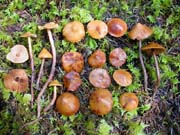
Ron Exeter
4b. Stipe polished, corneous; pseudorhiza brittle and wire-like (criniform); cheilocystidia thin-walled, clavate; pleurocystidia absent; spores big-bellied with abrupt tilted beaks, ~9 × 5.75 µm; phenology late autumn and winter (October–January)
..........................................................P. attenuata
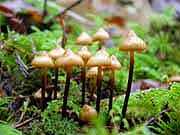
Ron Exeter
5a. (1) Young cap green, often aging brownish olive or brown; spores limoniform
..........................................................6
5b. Young cap ochre, orange, tawny, brownish, or drab (never green); spore shape varied
..........................................................8
6a. (5) Young gills violet; spores moderately beaked, in face view fusoid or naviculate, verrucose to marbled, ~9 × 5.3 µm; cheilocystidia thin-walled, clavate with swollen to subcapitate heads, rarely forming filiform apical outgrowths
..........................................................P. fallax
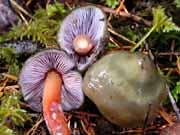
Ron Exeter
6b. Young gills creamy to yellowish buff; spores with pronounced beaks, +/- ovate in face view, heavily rugulose warty roughened, size varied; cheilocystidia varied
..........................................................7
7a. (6) Spores ~8 × 5 µm, with long, projecting beaks; cheilocystidia thick-walled, tibiiform with narrow refractive necks
..........................................................P. pseudofestiva
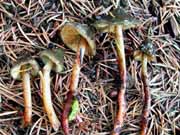
Ron Exeter
7b. Spores ~10 × 6 µm, ‘turtle-backed’ with abruptly protruding eccentric refractive beaks; cheilocystidia thin-walled, clavate, in age often with apical filiform outgrowths
..........................................................P. olivacea
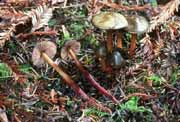
Michael Beug
8a. (5) Spores ellipsoid or limoniform, length |x| = < 7.5 µm; cheilocystidia uniformly thin-walled
..........................................................9
8b. Spores limoniform, length |x| = > 7.5 µm; cheilocystidia walls thin or thick
..........................................................13
9a. (8) Spores limoniform, marbled to verrucose; clamps absent; pileipellis 2- or 3-layered
..........................................................10
9b. Spores ellipsoid, punctate-roughened; clamps present or not; pileipellis 2-layered
..........................................................11
10a. (9) Fruitbody small to medium, fragile (stipe ≤ 7 mm & cap ≤ 60 mm diam); cap bald, glutinous, tawny to dark brown; stipe polished, drab to violet (apex); stuffed to hollow, often insect-infested; pileipellis 2-layered with colorless top layer, dull brownish bottom layer; spores ~6.9 × 4.3 µm
..........................................................P. rifflipes
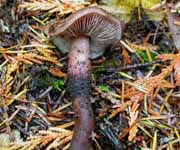
Ron Exeter
10b. Fruitbody large, robust (stipe ≤ 28 mm & cap ≤ 120 mm diam); cap appressed-scaly, subviscid (never glutinous), ochraceous tawny to tawny; stipe matte, tan to brown, firmly stuffed, never insect infested; pileipellis 3-layered with yellow-orange top and bottom layers, colorless middle layer; spores ~7.4 × 4.7 µm
..........................................................P. ochraceocana
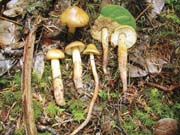
Ron Exeter
11a. (9) Fruitbody overall drab to gray, robust with stout firmly stuffed pink to drab stipe (≤ 20 mm diam) and fleshy pseudorhiza; taste and odor cucumber-farinaceous; all tissues soon deep magenta in syringaldazine; spores ~6.8 × 4 µm
..........................................................P. oregonensis
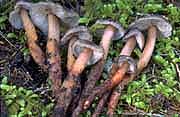
Lorelei Norvell
11b. Fruitbody overall orange, lacking drab colors, fragile with slender hollow tan stipe (≤ 13 mm diam) and cord-like pseudorhiza; taste and odor mild; cap & gills syringaldazine negative
..........................................................12
12a. (11) Clamp connections abundant; cap bright to dull orange with yellowish margin; cheilocystidia irregularly filamentous to narrowly clavate; spores ~6.7 × 4.3 µm
..........................................................P. dissiliens
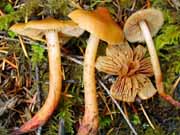
Ron Exeter
12b. Clamp connections absent; cap uniformly brownish orange to auburn; cheilocystidia narrowly clavate with long pedicels and swollen (subcapitate) heads; spores ~6.5 × 3.8 µm
..........................................................P. sipei
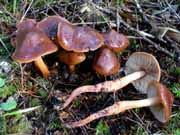
Ron Exeter
13a. (8) Cap minutely scaly (appressed), dry to subviscid (never glutinous), color ochre to tawny (never gray- or dark brown); pileipellis 3-layered with colorless gelatinized middle layer between yellow to yellow-orange top and bottom layers
..........................................................14
13b. Cap bald, smooth, subviscid to glutinous and never appressed scaly, colors varied; pileipellis 2-layered, with colorless top layer and variously pigmented lower layer
..........................................................15
14a. (13) Spores large, ~10 × 6 µm; cap dry to greasy, generally ochre (yellow-ochre, ochre-gold); frequently associated with Abies
..........................................................P. luteosquamulosa
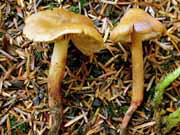
Ron Exeter
14b. Spores small, ~7.4 × 4.7 µm; cap greasy to subviscid, tawny ochraceous or tawny; associated with Pseudotsuga or Tsuga
..........................................................P. ochraceocana

Ron Exeter
15a. (13) Cheilocystidia tibiiform, with thin-walled broad bases and narrow, refractive, thick-walled necks and capituli; stipes hollow or stuffed; clamp connections absent
..........................................................16
15b. Cheilocystidia variably cylindrical to clavate, occasionally showing filamentous apical secondary growth in older specimens, but always lacking refractive thick-walled necks; stipes stuffed with firm pith; clamp connections present or absent
..........................................................18
16a. (15) Cap viscid, tawny to dark chestnut brown; mature stipe stuffed with firm compact pith; fruitbodies scattered to closely gregarious, arising from unbranched fleshy (not cord-like) pseudorhizas; spore median short, < 8 µm long
..........................................................P. spadicea
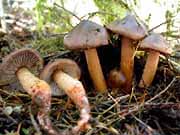
Ron Exeter
16b. Cap moist to glutinous, tawny orange to dull brown; mature stipe tubular and hollow; fruitbodies closely gregarious to fasciculate, arising from a rooting branching rhizomorphic cord; spore median medium-sized, > 8.5 µm long
..........................................................17
17a. (16) Cap heavily glutinous, acutely conic-campanulate, yellow- to dark-brown; densely fasciculate, with scores of variably aged fruitbodies arising from one point on the subterranean cord; suprapellis thick, colorless with hyphae submerged in thick gel matrix and not spirally pigment-encrusted; spores ~8.5 µm long
..........................................................P. scatesiae
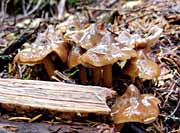
Ron Exeter
17b. Cap moist to viscid, obtusely convex-campanulate, red orange to tawny; clustered in troops or arcs (rarely in fasciculate mounds); suprapellis compact, pale amber to orange with hyphae spirally encrusted and with refractive septa; spores ~9 µm long
..........................................................P. californica
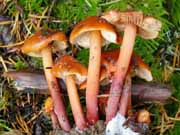
Ron Exeter
18a. (15) Clamp connections frequent throughout all tissues, most easily seen on the pileus suprapellis hyphae and cheilocystidia; cap convex-campanulate with an acutely pointed or often papillate umbo, tawny ochraceous to tawny; cheilocystidia cylindrical to narrowly clavate; spores ~9 × 5.5 µm
..........................................................P. ammiratii
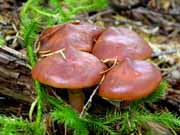
Ron Exeter
18b. Clamp connections lacking or rare (then only in stipe pellis); young cap shape & color, cheilocystidial shape, and spore sizes varied
..........................................................19
19a. (18) Young gills whitish, smoky gray, or deep violet; young caps tawny, brownish-pink or drab; cap & gills magenta in syringaldazine
..........................................................20
19b. Young gills pinkish, orangish, or yellowish; young caps varied, but rarely pink or drab; cap & gills magenta or not in syringaldazine
..........................................................21
20a. (19) Young gills intensely bluish lilac to violet; cap tawny when young, soon darkening to dark brown; pseudorhiza syringaldazine negative; taste not farinaceous; spores ~8 × 5 µm
..........................................................P. lilacifolia
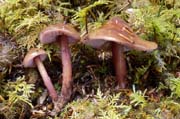
Steve Trudell
20b. Young gills white (occasionally pinkish) or ash gray, never lilac or violet; cap pinkish, drab, or purple-brown; all tissues soon deep magenta in syringaldazine; taste ‘bitter cucumber’ farinaceous; spores ~9 × 5.5 µm
..........................................................P. benzokauffmanii
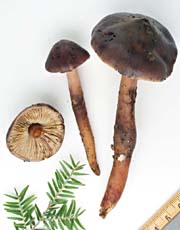
Lorelei Norvell
21a. (19) Young cap yellow tan, usually lacking orange colors and zonate with darker banded edge, soon chestnut- or cocoa brown (rarely grayish or drab); young stipe ivory tan, with lower stipe staining orange with orange band at ground level; habit fasciculate, densely gregarious; young gills dark under UV; all tissues syringaldazine negative; spores moderately large, ~9.5 × 5.7 µm
..........................................................P. gregaria
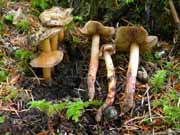
Ron Exeter
21b. Cap orangish to tawny, when young either overall orange, red-orange, or tawny or zonate with tawny to apricot-brown disc and pale amber margin; young stipe orange, buff, or pale cinnamon, lower stipe color varied; habit solitary, scattered, or gregarious; young gills fluoresce under UV; syringaldazine reactivity and spore size varied
..........................................................22
22a. (21) Fruitbody moderately small to large; stipe slender (apex ≤ 12 mm diam), stuffed but soon insect-eaten at ground level; cap subviscid, uniformly bright apricot- to peach-colored, with conic umbo; all tissues negative in syringaldazine; pileipellis hyphae colorless, spirally gel-incrusted, subpellis pigments diffuse, not encrusting; spores ~9.4 × 6 µm, beaks short (≤ 5 µm), straight
..........................................................P. piceae
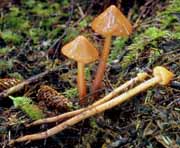
Lorelei Norvell
22b. Fruitbody moderately large to massive; stipe robust (apex ≤ 25 mm diam), stuffed with firm, insect-free pith; cap viscid to glutinous, orange, tawny, or orange-/red-brown or zonate with tawny disc, amber margin, tan edge, umbo obtuse; all tissues strongly magenta in syringaldazine; pileus subpellis hyphae pigment-encrusted; spores varied in size, beaks long (≤ 1.5 µm), tilted or straight
..........................................................23
23a. (22) Young to mature cap +/- uniformly orange, tawny, or dark orange-brown; lower stipe and pith staining first orange, then orange-brown; spores medium (~8.5 × 5 µm), lemon-shaped with tilted beak; cheilocystidia cylindrical or narrowly to broadly clavate, rarely pedicellate and subcapitate
..........................................................P. kauffmanii
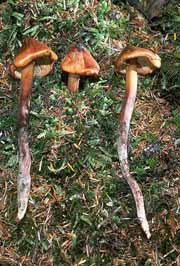
Michael Beug
23b. Young cap zonate with reddish tawny umbo, amber margin and tan edge, aging to overall tawny brown to dark red-brown; lower stipe and pith staining red-brown; spores large (~10.5 × 6 µm), almond-shaped with long ‘belly’ and slightly tilted beak; cheilocystidia usually pedicellate and catenulate, subcapitate with subglobose apices
..........................................................P. redheadii
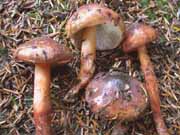
Ron Exeter